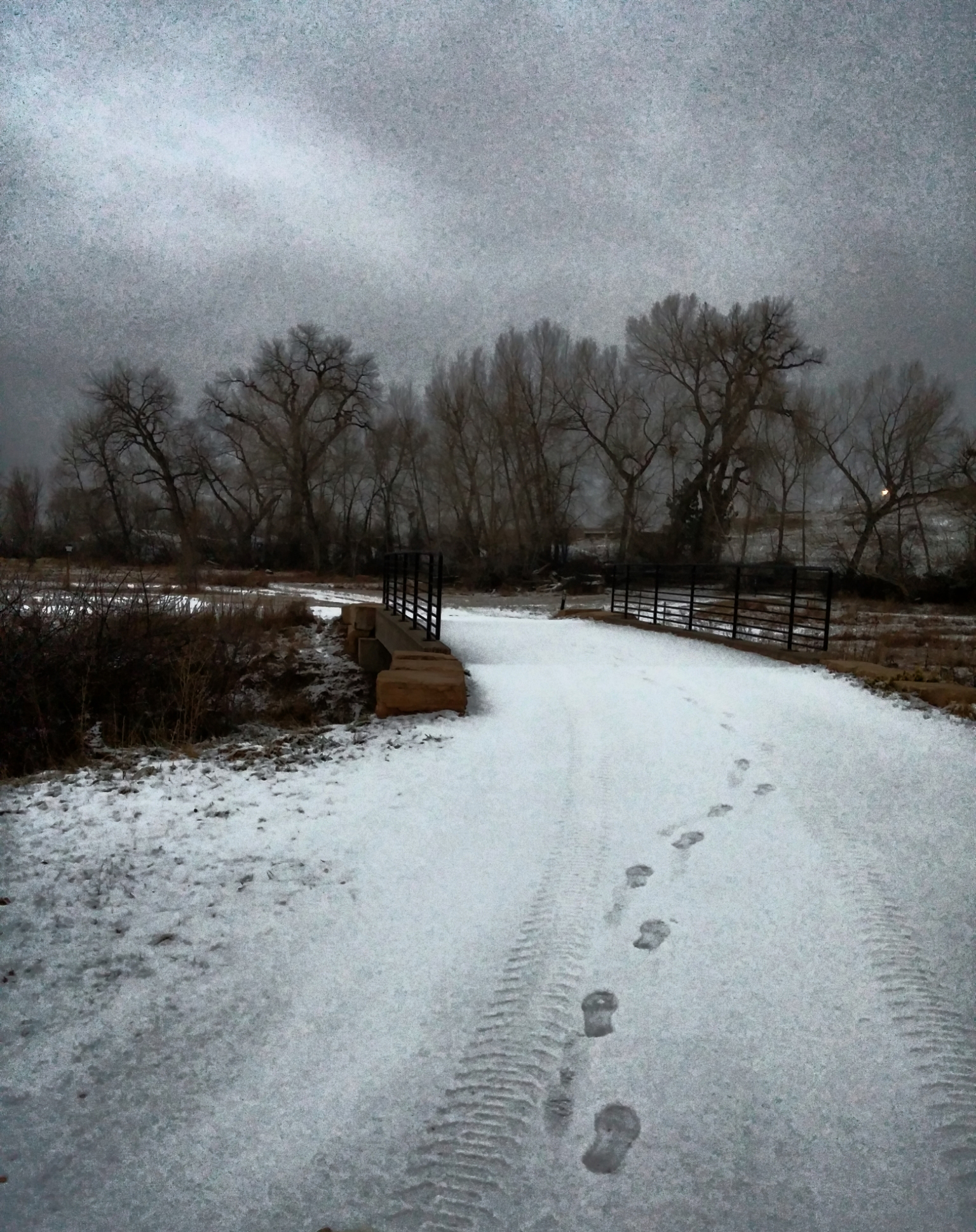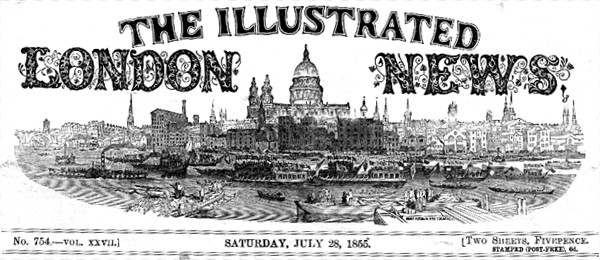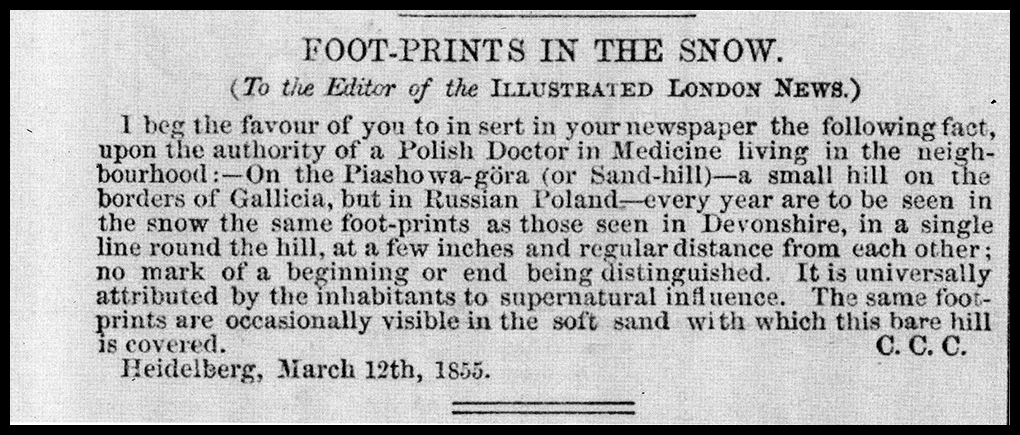Devon, 8/9 February 1855
Of all the strange weather stories I have read about over the last few years, I remember that of the Devil’s Footprints above all. It happened exactly 160 years ago, on the night of 8 February 1855. It is a mystery of Sherlockian proportions. It remains unsolved to this day.
The start of 1855 was unusually cold. The temperatures remained around freezing from January until March. Many rivers were frozen– among them the Exe and the Teign in Devon. Too cold for a thaw, each winter shower added to the mass of snow, creating the conditions for the story that follows.
The best place to begin is with a letter, written to the editor of the Exeter and Plymouth Gazette:
Sir, Thursday night, the 8th of February [1855], was marked by a heavy fall of snow, followed by rain and boisterous wind from the east, and in the morning frost.
The return of day-light revealed the ramblings of some most busy and mysterious animal, endowed with the power of ubiquity, as its foot-prints were to be seen in all sorts of unaccountable places – on the tops of houses, narrow walls, in gardens and court yards, enclosed by high walls and palings, as well as in the open fields. The creature seems to have frolicked about through Exmouth, Littleham, Lympstone, Woodbury, Topsham, Starcross, Teignmouth, &c. &c.
There is hardly a garden in Lympstone where his foot-prints are not observable, and in this parish he seems to have gambolled about with inexpressible activity. Its tracks appear more like that of a biped than a quadruped, and the steps are generally eight inches in advance of each other, though in some cases twelve or fourteen, and are alternate like the steps of a man, and would be included between two parallel lines six inches apart.
The impression of the foot closely resembles that of a donkey’s shoe, and measures from an inch and a half to (in some cases) two inches and a half across, here and there appearing as if the foot was cleft, but in the generality of its steps the impression of the shoe was continuous and perfect; in the centre the snow remains entire, merely showing the outer crust of the foot, which, therefore, must have been convex.
The creature seems to have advanced to the doors of several houses, and then to have retraced its steps, but no one is able to discern the starting or resting point of this mysterious visitor. Everyone is wondering, but no one is able to explain the mystery; the poor are full of superstition, and consider it little short of a visit from old Satan or some of his imps.
The prints stretched for between 40 and 100 miles around the south Devon coastline, and it was the unusual cloven, hoof-like shape of the marks that suggested a link with Satan. A cloven hoof was such a well-known characteristic of the Devil, a detail absorbed into popular poetry and art. Daniel Defoe had even written an essay ‘Of the extraordinary appearance of the Devil, and particularly of the cloven foot.’
For Trewman’s Exeter Flying Post, the story was ‘An excitement worthy of the dark ages’ and they published a piece on the ‘foot-tracks of a most strange and mysterious description’. In Dawlish a group of tradesmen were so unnerved that they armed themselves with ‘guns and bludgeons’ and on the morning of 9 February set off in pursuit of the tracks.
They walked from Dawlish to Luscombe, Dawlishwater and Oaklands. ‘At length, after a very long and weary search, they returned as wise as they set out.’
National Attention
Within a fortnight the story of the ‘Mysterious Foot-Prints’ was being reported in the local and national press. In particular it made its way into the Illustrated London News – the enormously popular weekly – by way of a letter ‘From a Correspondent’ on the ‘Foot-Marks on the Snow, in Devon’. It included additional information:
The marks which appeared on the snow (which lay very thinly on the ground at the time), and which were seen on the Friday morning, to all appearances were the perfect impression of a donkey’s hoof – the length 4 inches by 2 ¾ inches; but instead of progressing as that animal would have done (or indeed as any other would have done), feet right and left, it appeared that foot had followed foot, in a single line; the distance from each tread being eight inches, or rather more – the foot-marks in every parish being exactly the same size, and the steps the same length.
It’s interesting to note here the use of the word ‘foot-marks’. The word footprints had yet to find its way into the English language. Detection as an art was in its infancy and the vocabulary of the detective remained unsettled.
The letter to the Illustrated London News continued:
This mysterious visitor generally only passed once down or across each garden or courtyard, and did so in nearly all the houses in many parts of several towns above mentioned, as also in the farms scattered about.
This regular track passing in some instances over the roofs of houses, and hayricks, and very high walls (one fourteen feet), without displacing the snow on either side or altering the distance between the feet and passing on as if the wall had not been any impediment.
The gardens with high fences or walls, and gates locked, were equally visited as those open and unprotected. Now, when we consider the distance that must have been gone over to have left these marks – I must say in almost every garden, on door-steps, through to the extensive woods of Luscombe, upon commons, in enclosures and farms – the actual progress must have exceeded a hundred miles.
This act of ‘visiting’ homes by night also had religious undertones, stirring memories of the Plague of the First Born in Exodus, when God passed from house to house at midnight – saving only the firstborn sons of Israelites who marked their doors with lamb’s blood.
For some this and the cloven foot were enough to make the marks the Devil’s Footprints, but the author of the letter in the Illustrated London News kept his mind on a rational explanation.
Birds could not have left these marks, as no birds feet leaves the impression of a hoof, or, even were there a bird capable of doing so, could it proceed in the direct manner above stated – nor would birds, even had they donkeys’ feet, confine themselves to one direct line, but hop here and there: but the nature of the mark at once sets aside its being the track of a bird …
The writer of the above has passed a five months’ winter in the backwoods of Canada, and has much experience in tracking wild animals and birds upon the snow, and can safely say, he has never seen a more clearly defined track, or one that appeared to be less altered by the atmosphere than the one in question.
He rounded off:
Should you think the above likely to interest your readers, or draw from any of them a better solution of this most singular occurrence than has at present been given, perhaps you will allow it a place in your most interesting journal.
This letter sparked a spate of conjecture in the Illustrated London News. Already circulating the Devon towns were theories that the tracks were of a kangaroo, a wolf, or ‘another beast escaped from a travelling menagerie.’
(For the next month suggestions from correspondents across Europe appeared in the newspapers)
Theories
Letters to the newspaper from zoologists and naturalists now speculated that it was made by the hind foot of a badger or a Great Bustard or, somehow, by an errant otter or an extraordinary hopping frog.
One writer ventured that ‘The foot-marks described by your Devon Correspondent are made, in my opinion, by the poor, despised and insignificant rat.’ Another, mischievous, contribution claimed that the tracks were those of a Unipede, a fabulous and rarely sighted mammal that had been spotted by the Icelandic explorer Biom Herjolfsson in Labrador in the year AD 1001.
Whatever the case, today, 160 years after those Devon residents opened their doors and saw the foot tracks for the first time, we’re no more enlightened than they were then. Such is the lasting mystery of the Curious Case of the Devil’s Footprints.
—
Image credit for the photograph at the top: Carol Jacobs Carre



